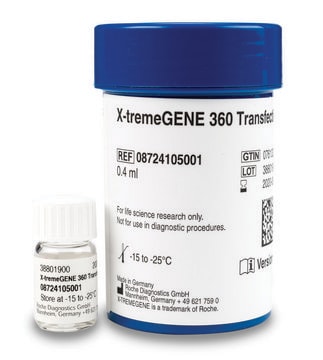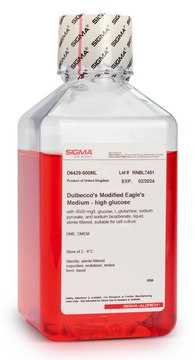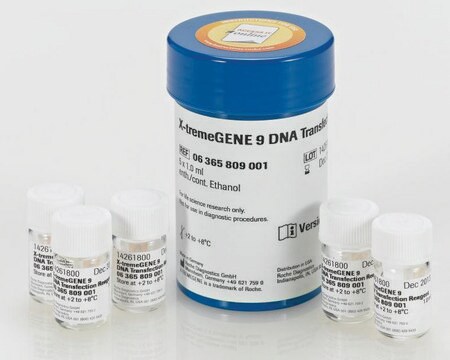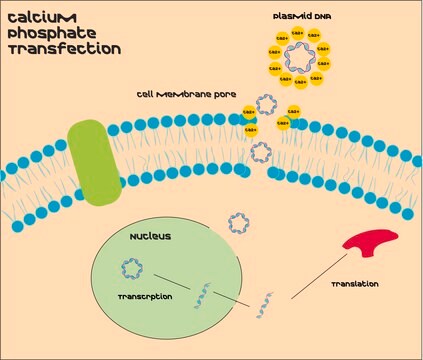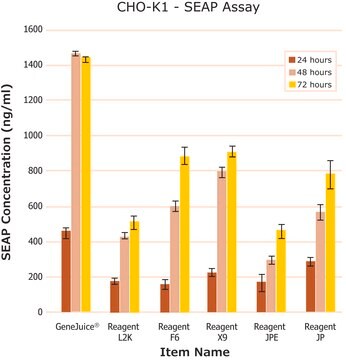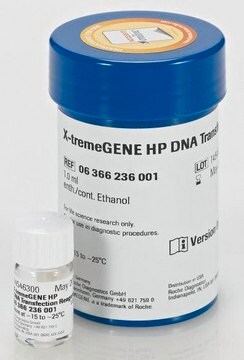N2913
N-TER™ Nanoparticle siRNA Transfection System
Se connecterpour consulter vos tarifs contractuels et ceux de votre entreprise/organisme
About This Item
Code UNSPSC :
12352200
Nomenclature NACRES :
NA.51
Produits recommandés
Forme
liquid
Conditions d'expédition
wet ice
Température de stockage
−20°C
Application
The N-TER Nanoparticle siRNA Transfection System is a peptide-based system for use in the transient knockdown of eukaryotic gene expression. The N-TER Peptide binds siRNAs non-covalently, forming a nanoparticle. This nanoparticle interacts directly with lipids on the surface of the plasma membrane, allowing the nanoparticle to diffuse across the cell membrane and deliver the siRNA directly to the cytoplasm. Unlike most lipid-based transfection methods, this novel delivery mechanism bypasses the endosomal pathway, eliminating possible compartmentalization and degradation of the siRNA.
Informations légales
Manufactured and Distributed by Sigma-Aldrich, under license from the CNRS.
N-TER is a trademark of Sigma-Aldrich Co. LLC
Code de la classe de stockage
12 - Non Combustible Liquids
Classe de danger pour l'eau (WGK)
nwg
Point d'éclair (°F)
Not applicable
Point d'éclair (°C)
Not applicable
Faites votre choix parmi les versions les plus récentes :
Déjà en possession de ce produit ?
Retrouvez la documentation relative aux produits que vous avez récemment achetés dans la Bibliothèque de documents.
Les clients ont également consulté
Federica Simeoni et al.
Nucleic acids research, 31(11), 2717-2724 (2003-05-29)
The improvement of non-viral-based gene delivery systems is of prime importance for the future of gene and antisense therapies. We have previously described a peptide-based gene delivery system, MPG, derived from the fusion peptide domain of HIV-1 gp41 protein and
L Crombez et al.
Biochemical Society transactions, 35(Pt 1), 44-46 (2007-01-20)
The major obstacle to clinical development of siRNAs (short interfering RNAs), like for most of the nucleic-acid-based strategies, is their poor cellular uptake and bioavailability. Although several viral and non-viral strategies have been proposed to improve siRNA delivery, their applications
Sébastien Deshayes et al.
Advanced drug delivery reviews, 60(4-5), 537-547 (2007-11-27)
The recent discovery of new potent therapeutic molecules which do not reach the clinic due to poor delivery and low bioavailability have made of delivery a key stone in therapeutic development. Several technologies have been designed to improve cellular uptake
Linlu Tian et al.
Scientific reports, 5, 12357-12357 (2015-07-24)
Melanoma is one of the most aggressive skin cancers and is well known for its high metastatic rate. Studies have shown that epithelial mesenchymal transition (EMT) is essential for melanoma cell metastasis. However, the molecular mechanisms underlying EMT are still
Joshua E Lewis et al.
Antioxidants & redox signaling, 29(10), 937-952 (2017-08-02)
The purpose of this study was to investigate differential nicotinamide adenine dinucleotide phosphate, reduced (NADPH) production between radiation-sensitive and -resistant head and neck squamous cell carcinoma (HNSCC) cell lines and whether these differences are predictive of sensitivity to the chemotherapeutic
Articles
This discussion will highlight some of these methodologies, namely, the use of Multiple Reaction Monitoring (MRM) and Protein-AQUA.
Notre équipe de scientifiques dispose d'une expérience dans tous les secteurs de la recherche, notamment en sciences de la vie, science des matériaux, synthèse chimique, chromatographie, analyse et dans de nombreux autres domaines..
Contacter notre Service technique